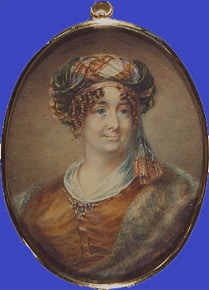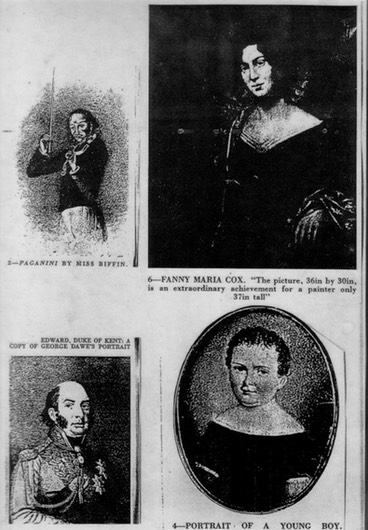1784 - 1850

This text had been provided by Richard Whittington-Egan
Thirty-seven inches in height, possessed of neither hands nor arms, Sarah Biffin would not seem exactly fitted by nature to follow the profession of an artist.
And yet this pathetically handicapped little fragment of humanity had her work hung at the Royal Academy, was awarded the Society of Art's medal, and enjoyed the patronage of four reigning monarchs. For sheer guts and courage in the face of overwhelming physical disabilities, those of us who are blessed with normal bodies and health and strength must give ungrudging admiration to one of the quaintest little creatures ever to be called a woman. She lies buried in St. James's Cemetery, for it was here in Liverpool that she spent the last years of her life.
The daughter of humble, though normal, parents, Sarah Biffin was born at East Quantoxhead, near Bridgewater in Somerset, on October 25th, 1784. A sensitive and independent-natured little girl, Sarah managed at an early age to acquire an amazing skill with the aid of her mouth and shoulders. She learned to use scissors, became an expert needlewoman and, while still in her 'teens, contrived to cut out and make all her own clothes.
There also developed in Sarah Biffin a deep and abiding passion for art, and when an artist named Dukes offered to give her lessons in painting she readily accepted. In return, she had to put herself entirely in Mr. Dukes's charge and was to travel about the country with him exhibiting herself and her achievements at rural fairs. Accordingly, an agreement was drawn up binding her to Mr. Dukes for a period of sixteen years and Sarah Biffin began her career as a fairground freak.
It is a sad comment upon human nature that, despite the large amount of money which she earned for him, at no time did Sarah receive more than £5 a year from Mr. Dukes. It was while exhibiting herself at one of the Race Week fairs that Sarah was first seen by the Earl of Morton, and from that moment the little artist's success was assured. The earl was so impressed by her skill and courage that he commissioned her to paint his portrait. Delighted with the result, he showed it to George III and secured for her the King's favour.
She held numerous exhibitions of her work all over England, among them, one in the Liverpool Collegiate Institution in Shaw Street, and another in what was then the Liverpool Mechanics' Institute.
By now she was able to support herself entirely from the proceeds of her art, and this was undoubtedly the happiest period of her life.

That she did possess legs is an undoubted fact, but the extent to which she was capable of using her toes is far from certain. As far as her painting was concerned, her method was invariable. She always used a long-handled brush which she took from the table with her tongue and, placing the end under a loop or pin on her right shoulder, manipulated it with her mouth. A newspaper account of the day comments:
So exquisite is that lady's touch that she can with ease tie a knot on a single hair with her tongue.
With the death of the Earl of Morton things began to go badly with Sarah. Gradually her patrons fell away and there was no longer anyone with influence to help her obtain orders for her pictures.
Around about 1842 she came to Liverpool and after living in lodgings in various parts of the town settled down at Number 8 Duke Street. Here, at the age of 63, she found herself in very poor circumstances with nothing but the Civil List pension of £12 a year granted to her by William IV. To make matters worse, her eyesight began to fail and she suffered from general bodily infirmity. Fortunately, her plight came to the notice of Richard Rathbone and it was through his kindly exertions on her behalf that a sum was subscribed in order to purchase a small annuity, for her.
She died at Duke Street on October 2, 1850, aged 66.
____________________________________________________________________________________________________________________